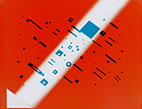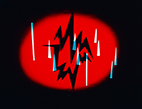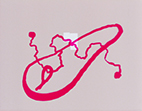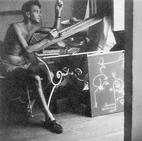Tarantella - Mary Ellen Bute
- Unseen Cinema Collection |
- 1940 |
- 5 minutes |
- COLOR |
- SOUND
Rental Format(s): Digital File
Co-makers: Mary Ellen Bute, Ted Nemeth, Norman McLaren
Original format: 35mm sound film 1.37:1
Production: Ted Nemeth Studios
Animation: Norman McLaren
Music: Edwin Gerschefski
Courtesy: Mary Ellen Bute, Theodore Nemeth
This new medium of expression is the Absolute Film. Here the artist creates a world of color, form, movement, and sound in which the elements are in a state of controllable flux, the two materials (visual and aural) being subject to any conceivable interrelation and modification. -Mary Ellen Bute
Color freed Bute's talent - where before she had been constrained by a quasi-scientific conception of the parallels between musical and visual dynamics. In Tarantella, she takes a more intuitive approach linked closer to Kandinsky, making it among Bute's most avant-garde productions. The animation used drawings illuminated in various wondrous ways. -R. Bruce Elder
By 1940, Mary Ellen Bute's abstractions were shown at select theaters nationwide. Her "seeing-sound" film, co-animated with Norman McLaren, demonstrates an ability to visualize music in a tradition sympathetic to modernist painting. Squiggling lines, expanding and contracting circles, and dynamic color fields frame Bute as a "designer of kinetic abstractions." -Bruce Posner
At the outbreak of World War II, Norman McLaren (1914-1987) left London for New York, where he remained over a year before joining the National Film Board of Canada and becoming a world leader in experimental animation. Almost destitute in New York, McLaren worked briefly for the Guggenheim Museum and for animator Mary Ellen Bute. -Cecile Starr
Infatuated with the new non-objective paintings of Kandinsky and others, Texas debutante Mary Ellen Bute (1906-1983) devoted twenty years (1932-1952) to creating thirteen abstract motion pictures in black-and-white and color, with familiar classical music accompaniments. Many were shown at New York's Radio City Music Hall. In 1966, she made a feature based upon James Joyce, Passages from Finnegan's Wake. -Cecile Starr
Before filming Mary Ellen Bute's short abstract films (1931-1953), Theodore "Ted" J. Nemeth (1911-1986) learned his craft creating special effects for feature film "trailers." As head of his own New York studio, founded in 1940 the year Bute and he were married, he made documentaries, commercials, and short subjects, two of which were Academy Award nominees. -Aram Boyajian






